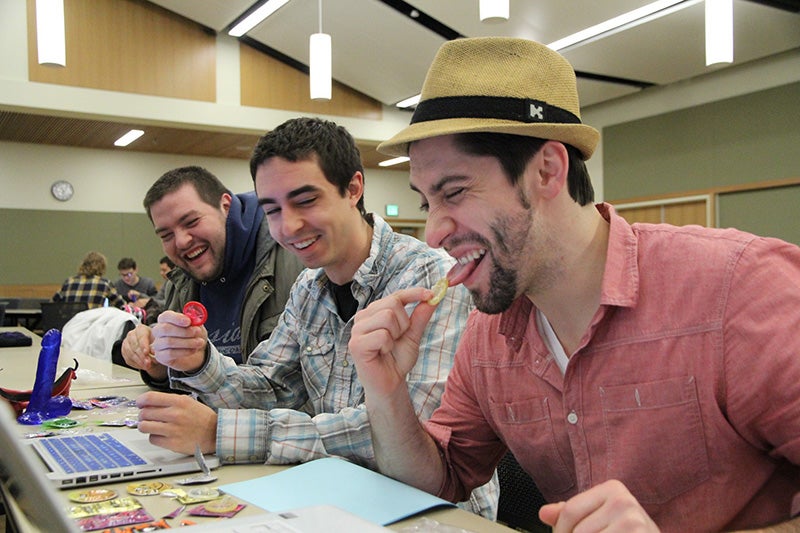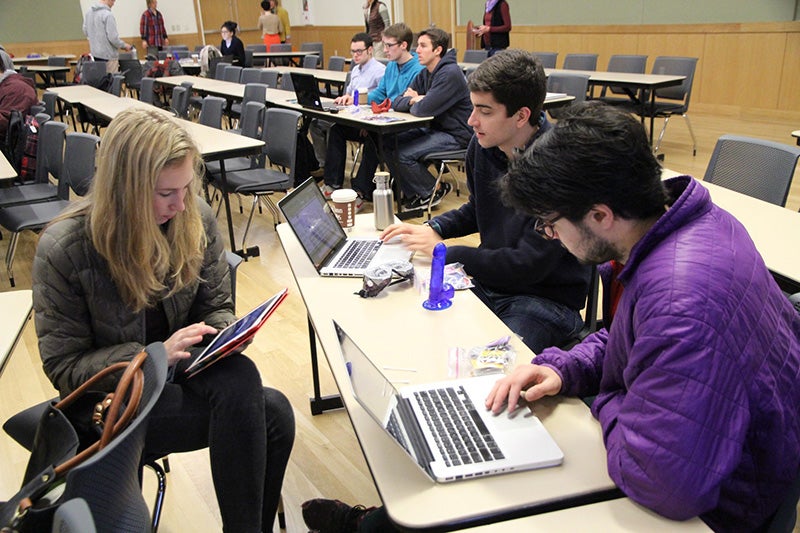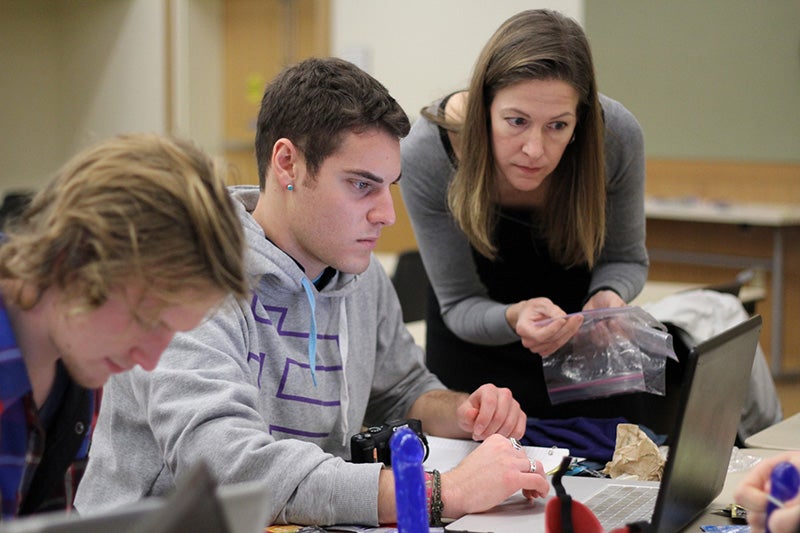Bulging bags of used condoms adorned tables less than an hour after students arrived. Comments including “Oh wow, that is really gross, it looks like a worm,” and “That’s, like, no lubrication, it’s already dry” could be heard as forty-five students clustered in small groups, laptops open to spreadsheets, iPhone stopwatches primed, cobalt blue plastic phalluses upright on tables before them.
The event—the most comprehensive condom test ever conducted anywhere—took place at the Global Scholars Hall on the UO campus in January. It included a massive data collection and documentation exercise using seventy-one different types of condoms generating approximately 600 results.
The exercise was just one day in the interdisciplinary class “Epic Challenges: Solving Massive Problems through Design Thinking,” offered winter 2014 through the Product Design Program.

Above: Using visual impairment goggles, a student prepares to test how long it takes to don a condom in simulated darkness. Photographs by Jack Liu.
“Design Thinking” emphasizes the benefits of interdisciplinary problem-solving. One course objective is to “fail early” in order to, through subsequent iterations, produce better final results. Another key skill that students are learning is lateral thinking, or approaching a problem from a variety of angles rather than head on.
Their efforts will culminate March 11, from 5-8 p.m., when the class will participate in a condom product design trade show, open to the public, in the EMU Ballroom.
Associate Professor Kiersten Muenchinger said she was “inspired to teach Epic Challenges by the mix of students' desires to solve real problems, and the possibility to have our own interdisciplinary Skunk Works® within the liberal arts community at UO.” (Skunk Works® refers to time-concentrated research and development by small teams working outside of routine procedures to design new concepts.)
Muenchinger, director of the Product Design Program, and Instructor John Park, of the UO Digital Arts Program, share teaching responsibilities for the class, which is being offered in response to a challenge by the Bill & Melinda Gates Foundation to design a “next generation condom that significantly preserves or enhances pleasure, in order to improve uptake and regular use.”
As the class syllabus explains, “There are Epic Challenges in the world that we wish someone would solve. These are problems … like disease prevention, global warming, and potable water access. These problems are massive, messy, chaotic, and controversial, making them difficult, if not impossible to solve.”
Because the class was offered across disciplines, human physiology major Hannah Seely spotted the listing in the class schedule and signed up. “I’ve traveled abroad to South Africa, where HIV is huge,” she said. “One issue is that people weren’t using condoms. They were handed out all the time but people wouldn’t even take them,” she said, explaining why she was drawn to a class with the aim of improving a product that could save literally millions of lives.
Experimentation was evident during the first data collection day in January. Students were asked to assess each condom for texture, sensitivity, lubricant, durability, strength, heat transfer, sound, taste, and more. Muenchinger encouraged students to be creative in developing tests; their ideas would be refined for subsequent test days. “I brought in a stethoscope if you want to use that for sound,” she said. “For heat transfer, think of something we can use in our next round of testing.” (In response, one student fetched an electric tea kettle.)

Above: A student performs a taste test on a condom as his team members, who later got to take a turn at the same test, look on. Students also performed tests for durability, packaging, texture, sensitivity, lubricant, strength, heat transfer, sound, and more.
Students were also expected to devise ways to assess factors such as duration of lubrication. “You could rub it against your wrist. What do you guys think? I know, it will look weird,” Muenchinger said, prompting laughter. “Take notes as you go.”
The students took the product testing steps seriously, taking care to treat each variable equally among different types of condoms and meticulously noting results. There was occasional laughter, but for the most part the students acted like responsible scientists.
Early in the term, each student was asked to consult with an “expert.” Biochemistry undergraduate Gaby Aufderheide met with an OB/GYN, whose expertise came in handy when Aufderheide’s group tested a texturized condom.
“My expert said the ribs and studs most likely do nothing, that women most likely don’t feel it,” she told teammates Sam Selbie and James Tuttle, both of whom are product design majors. “Interesting,” said Selbie. “Maybe it’s a psychological thing,” said Tuttle. “It feels good to the finger,” Aufderheide said, alluding to their test for sensitivity, “but from what I’ve read about studs, once the lube dries out it causes friction.” “So it’s a 2,” Selbie and Tuttle agreed, using a scale from 1 to 5.
Packaging attractiveness and ease of opening were also rubrics for the tests.
“It’s harder to open at nighttime because there’s no perforations,” Tuttle said of one condom. “So this one’s not doing so hot already,” Aufderheide noted. “There’s no place to open it,” Selbie observed. “So you kinda have to use your teeth,” Tuttle added, “which is, like, not recommended.”
Across the room, another group of students rolled their blue plastic phallus on a sheet of paper to see how well the lubricant was distributed from the head to the base. “It’s like a Rorschach test,” said biology major Cole Lendrum of the pattern that emerged on the paper. The group then tested the durability of the lubricant by stroking the condom, while installed on the phallus, until it felt dry. “Good work, first guy; good luck second guy,” business major Zack Rifai addressed the condom, which grew drier faster than the previous condom tested. ”It just feels like Saran Wrap.”

Above: Hannah Seely (from left), Zack Rifai, and Cole Lendrum input notes and numbers in between conducting tests. “I’ve traveled abroad to South Africa, where HIV is huge,” said Seely, a human physiology major. “People weren’t using condoms. They were handed out all the time but people wouldn’t even take them,” she said, explaining why she was drawn to a class with the aim of improving a product that could save literally millions of lives.
Tests for durability started out gently but developed in intensity depending on the product. One student stretched a condom taut over the phallus with both hands, watching the condom stretch tight but not break. He then tried pulling it off by the tip, stretching it out a couple of feet like a taffy pull, while his teammates watched expectantly, waiting for it to tear. It didn’t. In fact it was so tough that as the student pulled up on the condom, the phallus it was attached to—which was held by a suction cup to the table—literally lifted the table from the floor.
The students will refine their tests as the term progresses. They’ll also learn to write a grant, with other class days devoted to creating stories with words or images, and storyboarding a product concept. Lecture topics include “Intellectual Property,” “Presenting to Experts,” and “International Infographics,” among many others. Assigned readings include The Ten Faces of Innovation by Tom Kelley, Out of Poverty by Paul Polak, and the Wikipedia entry on Thomas Edison, among numerous other readings.
The students in Epic Challenges are working independently of UO Professor Richard Chartoff, a faculty member in the Department of Chemistry and director of the Polymer Characterization and Thermal Analysis Laboratory at the Center for Advanced Materials Characterization in Oregon (CAMCOR). In November 2013, Chartoff won a Gates Foundation “Grand Challenges Explorations” grant to pursue an innovative global health and development research project, “High Strength, Ultrathin Adaptable Condoms for Enhanced Sensitivity.”
Muenchinger and Park’s class is supported in part by funds from the Michael and Stacy Koehn Endowment Fund, which annually funds the year-long Koehn Colloquia.
The Gates foundation’s “Grand Challenges Explorations” underwrites individuals worldwide to explore ideas “that can break the mold in how persistent global health and development challenges are solved.” As part of the UO class, in addition to testing condoms and documenting the results, each student will prepare a grant proposal for Gates Foundation funding of further research.
The Product Design Program provides industrial design education at UO. Established in 2008 with a focus on sustainable product design, the program is part of the University of Oregon’s Green Product Design Network, a collaborative partnership with green chemistry, product design, business, and journalism and communication.
UO product design students and faculty members are regularly recognized for design excellence in competitions and awards. Achievements include awards given by the Land Art Generator Initiative (2013), Colligan User Interface Design Challenge (2012, 2013), Industrial Design Society of America Design Excellence Awards (2012, 2013), Interzinc Design Challenge (2008-2013), Oregon Manifest Design Challenge (2011), Ascent Solar Technologies Innovative Design Competition (2011), and Seoul International Design Competition (2010). To learn more, visit pd.uoregon.edu.

Above: Kiersten Muenchinger, director of the Product Design Program, works with product design major Conner Macfarlane to input data in a spreadsheet during the condom test day in January.
